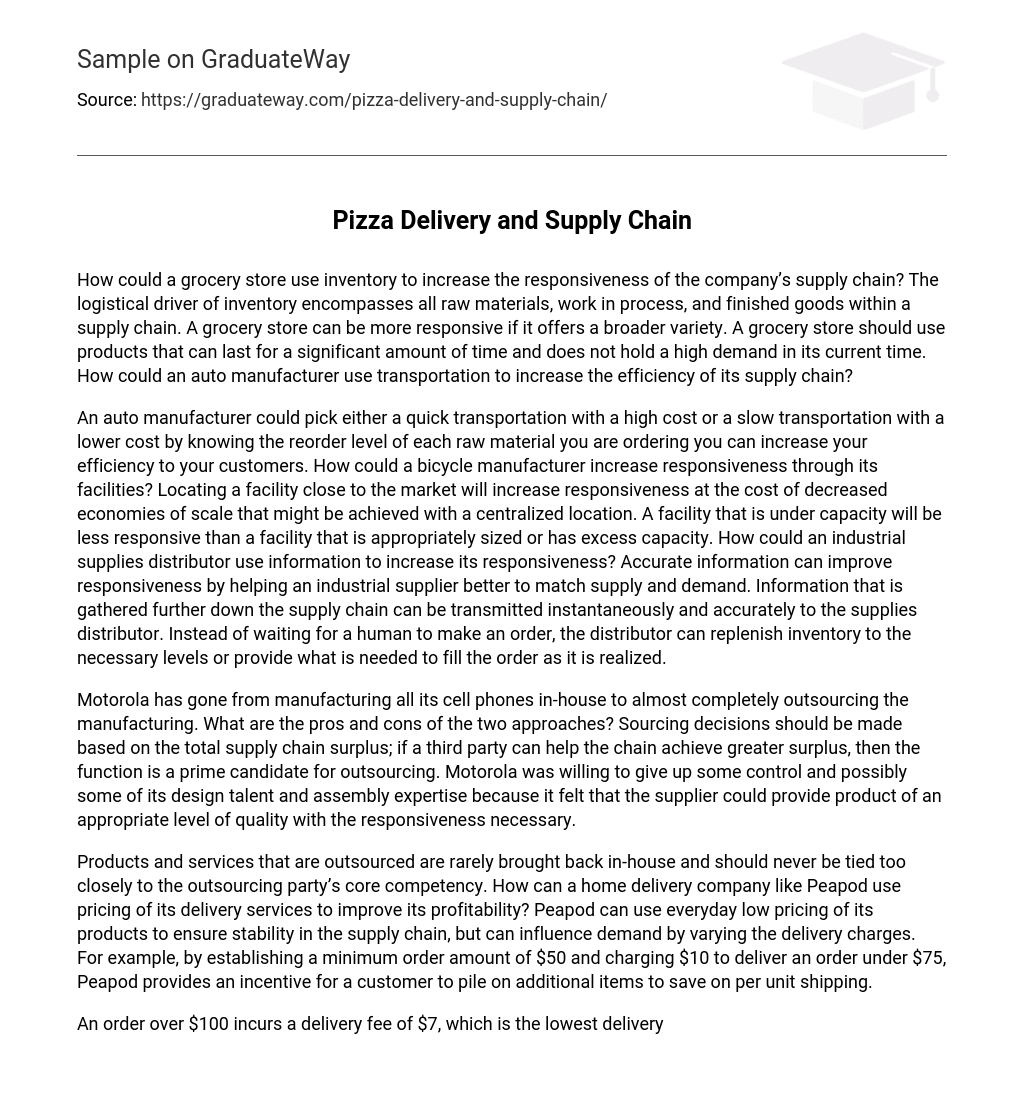How could a grocery store use inventory to increase the responsiveness of the company’s supply chain? The logistical driver of inventory encompasses all raw materials, work in process, and finished goods within a supply chain. A grocery store can be more responsive if it offers a broader variety. A grocery store should use products that can last for a significant amount of time and does not hold a high demand in its current time. How could an auto manufacturer use transportation to increase the efficiency of its supply chain?
An auto manufacturer could pick either a quick transportation with a high cost or a slow transportation with a lower cost by knowing the reorder level of each raw material you are ordering you can increase your efficiency to your customers. How could a bicycle manufacturer increase responsiveness through its facilities? Locating a facility close to the market will increase responsiveness at the cost of decreased economies of scale that might be achieved with a centralized location. A facility that is under capacity will be less responsive than a facility that is appropriately sized or has excess capacity. How could an industrial supplies distributor use information to increase its responsiveness? Accurate information can improve responsiveness by helping an industrial supplier better to match supply and demand. Information that is gathered further down the supply chain can be transmitted instantaneously and accurately to the supplies distributor. Instead of waiting for a human to make an order, the distributor can replenish inventory to the necessary levels or provide what is needed to fill the order as it is realized.
Motorola has gone from manufacturing all its cell phones in-house to almost completely outsourcing the manufacturing. What are the pros and cons of the two approaches? Sourcing decisions should be made based on the total supply chain surplus; if a third party can help the chain achieve greater surplus, then the function is a prime candidate for outsourcing. Motorola was willing to give up some control and possibly some of its design talent and assembly expertise because it felt that the supplier could provide product of an appropriate level of quality with the responsiveness necessary.
Products and services that are outsourced are rarely brought back in-house and should never be tied too closely to the outsourcing party’s core competency. How can a home delivery company like Peapod use pricing of its delivery services to improve its profitability? Peapod can use everyday low pricing of its products to ensure stability in the supply chain, but can influence demand by varying the delivery charges. For example, by establishing a minimum order amount of $50 and charging $10 to deliver an order under $75, Peapod provides an incentive for a customer to pile on additional items to save on per unit shipping.
An order over $100 incurs a delivery fee of $7, which is the lowest delivery charge for a residential customer. Peapod also varies delivery charges by time of day; evening delivery times on weekdays and morning deliveries on Sunday within narrow windows cost an extra dollar, wider delivery windows are $1 less. The delivery latitude allows Peapod’s delivery drivers to schedule more efficiently thereby increasing profitability.
What are some industries in which products have proliferated and life cycles have shortened?
How has the supply chains in these industries adapted? The example of running shoes increasing from five styles in the early 70s to almost 300 by the late 90s. Other products that have seen an explosion in variety include personal electronics, beverages, snack and prepared foods, entertainment, tires, and personal services. Supply chains have leveraged information systems, recognized the need to collaborate on product and process design, and supply chain execution. The supply chain stance has shifted towards a partnership orientation from a focus on price negotiations.
How can the full set of logistical and cross-functional drivers be used to create strategic fit for a PC manufacturer targeting both time sensitive and price conscious customers? A PC manufacturer that wants to deliver products both quickly and efficiently can make cost and time trade-offs among these drivers to achieve their goals. These trade-offs across drivers afford more flexibility but requires constant caution as the trade-offs within each driver change. In addition, some drivers may be altered more easily, e. g. , order quantity and transportation media, than other drivers, e. g. , location and sourcing.





